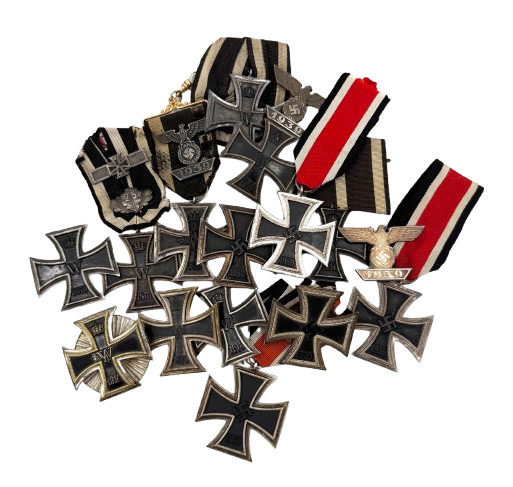Iron Cross Origins: From Napoleonic Wars to Nazi Germany
Iron Cross’s from all different eras.
The Iron Cross is one of the most recognizable military decorations in modern history, deeply entwined with German military tradition and national identity. Instituted in the early 19th century, it has undergone several periods of issuance, transformation, and reinterpretation, reflecting the tumultuous evolution of Germany from a collection of kingdoms into a unified nation-state and, later, a global power.
Established on March 10, 1813, by King Frederick William III of Prussia during the Wars of Liberation against Napoleon Bonaparte. Created in the spirit of national resistance and unity, it marked a significant departure from the aristocratic nature of earlier Prussian orders by being awarded to soldiers of all ranks. The design, featuring a black cross with silver trim, drew from the Teutonic Order and symbolized both Christian and militaristic virtues.
The medal was awarded in three main classes:
Iron Cross 2nd Class
Iron Cross 1st Class
Grand Cross of the Iron Cross, reserved for generals and senior commanders demonstrating exceptional leadership.
Notably, recipients included Gebhard Leberecht von Blücher, one of the principal commanders at the Battle of Waterloo.
In 1870 the cross was reissued during the Franco-Prussian War, again under Prussian leadership, this time by Emperor Wilhelm I. The core design and structure remained unchanged, reinforcing its symbolic continuity. Awardees included prominent military leaders such as Helmuth von Moltke the Elder. This reissuance further cemented the Iron Cross as a national emblem of German military prowess, culminating in the unification of Germany in 1871 and the rise of the German Empire.
With the outbreak of World War I, the Iron Cross was once again revived in 1914 by Kaiser Wilhelm II. The award saw widespread distribution during the war, with approximately five million Iron Crosses (2nd Class) issued. It continued to be awarded in two main classes and a Grand Cross, with an additional unique distinction: the Star of the Grand Cross, awarded only once to Field Marshal Paul von Hindenburg. During this period, the Iron Cross became a prominent patriotic symbol, featured in propaganda, literature, and popular culture.
After World War 1 the cross underwent a significant transformation under the Third Reich. On September 1, 1939, Adolf Hitler reintroduced the medal at the onset of World War II, adding a swastika to its design. While it retained the 1939 date and basic structure, the Nazi version of the Iron Cross served not only as a military decoration but also as a tool for ideological symbolism.
The hierarchy of the award expanded significantly:
Iron Cross 2nd and 1st Class
Knight’s Cross of the Iron Cross
Higher grades of the Knight’s Cross, including Oak Leaves, Swords, Diamonds, and the Golden Oak Leaves.
These distinctions recognized extreme acts of battlefield bravery or military leadership, with over 7,000 Knight’s Crosses awarded during the war. Notable recipients included Erwin Rommel, Michael Wittmann, and Hans-Ulrich Rudel.
After the war, the swastika-bearing versions of the Iron Cross were banned under German law.
Following World War II and the fall of the Nazi regime, the Iron Cross fell into disuse due to its association with militarism and fascism. However, in 1957, the Federal Republic of Germany (West Germany) permitted the wearing of de-Nazified versions of the Iron Cross (with the swastika replaced by oak leaves), primarily for WWII veterans.
In a significant move, the Bundeswehr, the postwar German armed forces, adopted a stylized version of the Iron Cross as its emblem. This version emphasizes continuity with older Prussian military traditions while explicitly distancing itself from the Nazi period.


